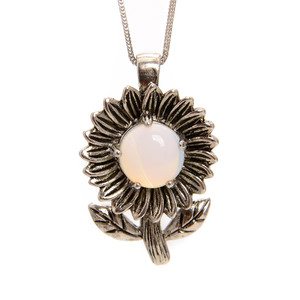
Red Jasper, Natural, Sunflower, One Pendant, 33x22mm
Red Jasper, Natural, Sunflower, One Pendant, 33x22mm
Red Jasper can be found all corners of the earth. From the sands of Madagascar to the rainforests of Brazil, and the deserts of Australia, you can find Red Jasper. It is also found in the western areas of the Unites States; California, Oregon, Idaho, Utah, Wyoming and Washington. Red is the most common color for Jaspers and it gets its hue from the presence of iron. Jasper usually contains up to 20% of foreign materials which are what give the Jasper gemstone its many color variations.
Jasper is a member of the chalcedony family. It is usually an opaque stone with a solid color or an irregular display of colors caused by various mineral impurities. Its colors are usually red, yellow, brown, or green in color and rarely blue. The common red color is due to iron inclusions. It often contains an abundance of impurities, and therefore some regard it as a rock instead of a mineral. Patterns arise during the consolidation process forming flow and depositional patterns in the original silica rich sediment or ash. The Jasper name means "spotted or speckled stone".
Jasper is known to have been a favorite gem in the ancient world; its name can be traced back in Arabic, Persian, Hebrew, Assyrian, Greek and Latin. Jasper in mentioned many times in the Bible. Green jasper was used to make bow drills between 4th and 5th millennium BC.
Hardness 6.5-7
These pendants were made in China.
Metal Alloy is a metal made by combining two or more metallic elements, base metals, to give greater strength or resistance to corrosion. In mining and economics, base metals refer to industrial non-ferrous metals excluding precious metals, like silver, gold, and platinum. Base Metals include copper, aluminum, nickel, tin, zinc antimony, bismuth, lead and many more. Metal Alloy, also known as Pewter and is usually a tin based alloy 85-95% of the time but could also be zinc based.
In December of 1994, The US Safe Drinking Water Act defined Lead-free as having less than 0.25% lead content. Most newly made solid pewter on the market today is considered lead free by these standards. But it is still recommended to not give children Metal Alloy jewelry if there is any chance, they will put it in their mouths!











